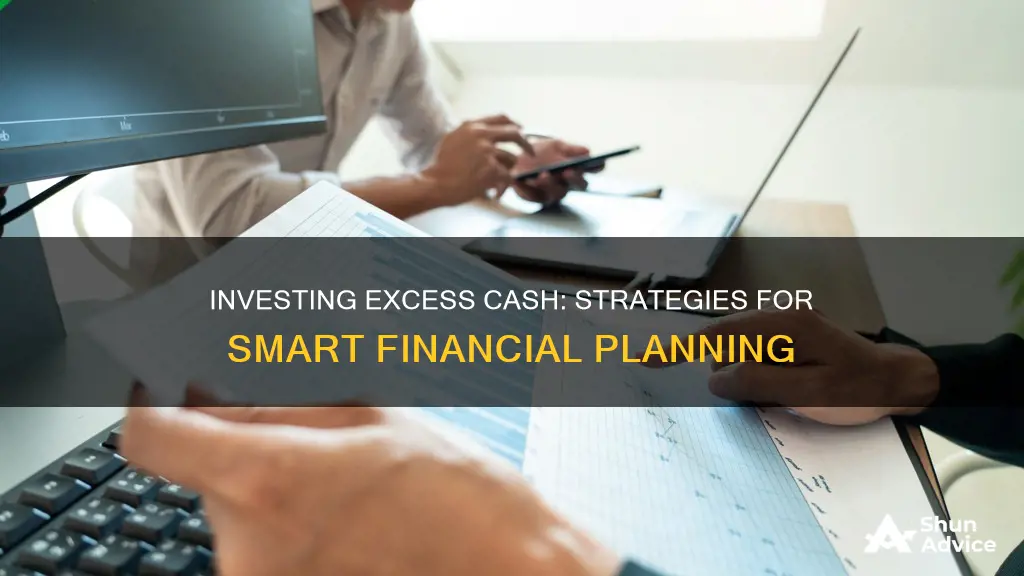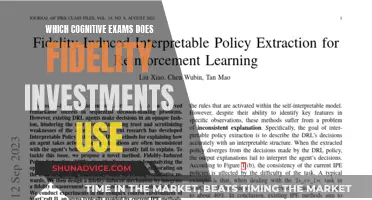
Investing excess cash can be a tricky endeavour, but there are a few general rules to follow. Firstly, it is recommended to pay off any high-interest debt, such as credit cards, as this will free up more money each month and help you avoid costly interest charges. Secondly, ensure you have an emergency fund with enough money to cover your living expenses for at least three to six months. This will provide a safety net and protect your investments in case of unexpected expenses. Once you have a solid financial footing, you can start thinking about investing your excess cash in a variety of ways, including increasing your retirement plan contributions, investing in stocks, real estate, or cryptocurrencies, or even starting your own business. It is important to do your research, understand your risk tolerance, and consider seeking advice from a financial professional to determine the best investment strategies for your specific situation.
| Characteristics | Values |
|---|---|
| Pay off debt | High-interest debt, e.g. credit cards |
| Build emergency fund | 3-6 months' living expenses |
| Diversify investments | Mutual funds, stocks, real estate, bonds, cryptocurrencies |
| Increase retirement plan contributions | Save at least 15% of income for retirement |
| Invest in a fund | Mutual funds, exchange-traded funds (ETFs) |
| Buy individual stocks | Open a brokerage account |
| Invest in real estate | REITs |
| Get a bank account bonus | Open a new bank account |
| Invest in yourself | Education, business |
What You'll Learn

Pay off high-interest debt
Paying off high-interest debt is a smart move if you have extra cash. This is especially important if you have variable interest rates, as your debt could become even more expensive. Credit card debt, personal loans, and student loans are common examples of high-interest debt.
- Save on interest charges: High-interest debt, such as credit card debt, can lead to costly interest charges over time. By paying off this debt, you can avoid these charges and save money.
- Free up monthly income: When you pay off high-interest debt, you eliminate the need to make monthly payments, freeing up more money in your budget for other expenses or financial goals.
- Improve cash flow: Reducing high-interest debt improves your cash flow, giving you more flexibility to invest, save, or spend on other priorities.
- Achieve financial goals: Paying off debt is a crucial step towards achieving financial goals, such as buying a house or investing in yourself or your education.
- Peace of mind: High-interest debt can be a source of stress and worry. Eliminating this debt improves your financial stability and provides peace of mind.
When deciding which high-interest debt to pay off first, consider the following factors:
- Interest rate: Focus on debt with the highest interest rates, such as credit card debt or payday loans.
- Balance: Prioritize debt with the smallest balance to gain quick wins and stay motivated.
- Impact on credit score: Target revolving debt, such as credit card debt, as it can damage your credit score due to a high credit utilization rate.
- Tax implications: Ensure you prioritize any tax debt to avoid legal issues and penalties.
To effectively pay off high-interest debt, make a plan and stick to it. Make at least the minimum monthly payments on all your debts, and use any extra funds to pay off the debt with the highest interest rate or smallest balance, depending on your strategy. Once that debt is cleared, move on to the next one until you become debt-free.
Understanding Net Cash Flow from Investing Activities
You may want to see also

Build an emergency fund
Building an emergency fund is a crucial step in achieving financial stability and security. This fund will ensure you are prepared for unexpected expenses, such as car repairs, home repairs, medical bills, or a loss of income. Here are some detailed and instructive steps to help you build an adequate emergency fund:
Determine the Amount You Need:
The amount you should ideally save in your emergency fund depends on your unique situation. Consider your previous unexpected expenses and how much they cost. Generally, it is recommended to have enough to cover anywhere from three to six months' worth of living expenses. If you have dependents or are the sole income provider, you may want to save up to eight months' worth of expenses.
Set Achievable Goals:
To stay motivated, set smaller, achievable goals rather than one large, overwhelming goal. For example, start by aiming for one month's worth of expenses, and then gradually increase your goal. Reaching these smaller milestones will give you a sense of accomplishment and encourage you to continue saving.
Start with Small, Regular Contributions:
Begin with small and manageable contributions to your emergency fund. Determine an amount you can comfortably set aside each month, week, or payday. You can cut back on non-essential expenses, like a daily coffee habit or a night out, and allocate that money to your savings instead.
Automate Your Savings:
Automating your savings is an effective way to save without constantly thinking about it. Set up automatic recurring transfers from your checking account to your savings account. You can do this through your bank or employer, especially if they offer direct deposits. Choose an amount that works for you, and don't forget to monitor your balances to avoid overdraft fees.
Choose the Right Account:
Select an account that is safe, accessible, and separate from your day-to-day spending money. A basic savings account or a money market account linked to your checking account are good options. Look for accounts with no annual fees and consider those that offer a small annual yield.
Only Use the Fund for Emergencies:
True emergencies, such as car trouble, job loss, home repairs, or medical issues, are valid reasons to tap into your emergency fund. Stay disciplined and don't be tempted to use the fund for non-essential purchases. If you do use the money, be sure to replenish the account as soon as possible.
Remember, building an emergency fund takes time and discipline. Start with small steps, and you'll be on your way to achieving financial stability and peace of mind.
Fidelity's Cash Policy: What Investors Need to Know
You may want to see also

Invest in stocks and bonds
Investing in stocks and bonds is a great way to make your excess cash work for you. Both stocks and bonds are integral to investment planning discussions. Here are some key things to keep in mind:
Stocks
When you buy a share of stock, you buy a stake in a company. Share prices can increase over time as the company's performance and profits increase, but they can also decrease if the company's performance declines. Stocks typically have the potential for higher returns compared to other types of investments over the long term, but they also come with greater risk. It's a good idea to diversify your stock portfolio by investing in more than one company, industry, and kind of stock.
There are several types of stocks to choose from, including:
- Growth stocks: Often in new or growing industries with the potential for earnings to increase faster than the market average.
- Value stocks: Stocks from companies with good earnings that are selling shares at lower prices relative to their value.
- Income (or high-dividend) stocks: These usually pay steady dividends but historically have not seen strong share price growth.
- Blue-chip stocks: Stocks from large and well-regarded companies with a strong growth history that often pay dividends.
Bonds
When you buy a bond, you are loaning money to the bond issuer, typically a company or government agency. Bonds have a maturity date when the loan is due to be paid in full, and they usually offer fixed or variable interest payments. Bonds tend to be more stable than stocks and are a good option for investors who are more risk-averse.
There are several types of bonds available, including:
- Corporate bonds: Issued by private corporations to pay off debt.
- Investment-grade bonds: Offer lower yields due to lower interest rates and higher credit ratings.
- High-yield bonds: Offer higher interest rates due to lower credit ratings and a higher risk of default.
- Municipal bonds: Issued by states, counties, or municipalities and are usually exempt from federal income tax.
- Government bonds: Considered a lower-risk investment option, typically backed by the U.S. government and guaranteed to be paid in a timely manner with interest.
Stocks vs. Bonds
Stocks and bonds each have a different level of risk and behave differently in response to changes in the financial markets. Stocks offer an opportunity for higher long-term returns compared to bonds but come with greater risk. Bonds, on the other hand, are generally more stable but have provided lower long-term returns. By investing in both stocks and bonds, investors can take advantage of rising markets while also limiting losses when markets decline.
Getting Started
If you're new to investing in stocks and bonds, consider working with a financial professional to help you create a personalized investment portfolio based on your goals, time horizon, and risk tolerance. You can also start by investing in mutual funds, index funds, or exchange-traded funds (ETFs) to diversify your holdings and have greater variety in your asset allocation.
Remember, investing involves risk, and there is no guaranteed return. Be sure to do your research and understand the risks and potential rewards of any investment before committing your money.
Robinhood Brokerage Cash: Investing Strategies for Beginners
You may want to see also

Diversify your portfolio
Diversifying your portfolio is a great way to manage risk and maximise returns. Here are some tips to help you diversify your portfolio:
- Determine your risk tolerance: Before investing, it's important to assess your risk tolerance. Consider how much risk you are comfortable taking on, which may depend on your investment goals, time horizon, and financial situation.
- Asset allocation: Diversification involves allocating your investments across different asset classes, such as stocks, bonds, cash, and other investments. Your asset allocation should generally align with your risk tolerance. For example, if you have a higher risk tolerance, you may be able to allocate a larger portion of your portfolio to stocks or other higher-risk, higher-return investments.
- Choose specific investments: You can diversify your portfolio by investing in mutual funds, exchange-traded funds (ETFs), individual stocks, and bonds. Mutual funds and ETFs offer an easy way to invest in a diversified basket of securities without having to pick individual stocks. When selecting individual stocks, conduct thorough research and consider investing in different sectors and industries to spread your risk.
- Gradual investment: Once you've determined your investment strategy, you can choose to invest a lump sum all at once or gradually over time. Investing a lump sum provides more time in the market, but gradual investing may be more comfortable and can be automated.
- Avoid timing the market: Don't obsess over finding the perfect time to invest. Focus on your long-term investment goals and remember that missing out on a few days of market gains can impact your portfolio's returns. Historically, investing during downturns has provided some of the best subsequent returns.
- Seek professional help: If you need assistance or feel overwhelmed, consider consulting a financial advisor or a robo-advisor. They can provide guidance, create a personalised investment plan, and help you manage your portfolio based on your goals and risk tolerance.
Cashing Out Investments: Using the Cash App to Withdraw Funds
You may want to see also

Consider long-term investments
If you're looking to invest excess cash, one of the best ways to secure your financial future is to invest over the long term. Long-term investing is a well-tested strategy that many investors can benefit from.
Long-term investing for individuals is generally considered to be holding an investment for at least seven to 10 years, although there is no absolute rule. Being a long-term investor means that you are willing to accept a certain amount of risk in pursuit of potentially higher rewards, and that you can be patient for an extended period. It also suggests that you have enough capital to put away in financial assets for a long period until you need it.
- Robo-advisor portfolio: A robo-advisor is a great alternative if you don't want to do much investing yourself and prefer to leave it to an experienced professional. You'll fill out some questionnaires, and the robo-advisor will understand your goals, time horizon, and risk tolerance. Based on this, it will select funds and build you a portfolio. The potential reward depends on the investments and can range from very high if you own mostly stock funds to low if you hold safer assets.
- Roth IRA: A Roth IRA is a great vehicle for anyone earning income to pile up tax-free assets for retirement. It lets you save with after-tax money and grow your money tax-free for decades, and then withdraw it tax-free. You can invest in almost anything inside a Roth IRA, including stocks, stock funds, and CDs.
- Real estate: Real estate has long been considered one of the best long-term investments. It takes a good bit of money to get started, and the commissions are quite high, but the returns can be quite high as well. If you select a good property and manage it well, you can earn many times your investment over time. Real estate investment trusts (REITs) are one popular form of investing in real estate.
- Growth stocks: Growth stocks are the Ferraris of the stock world, offering the potential for high growth and high investment returns. They are often tech companies that plow their profits back into the business, so they rarely pay out dividends. Growth stocks can be risky, especially during a bear market or a recession, but they have been some of the best performers over time.
- Stock funds: A stock fund is a collection of stocks unified by a specific theme or categorization, such as American stocks or large stocks. A stock fund is less risky than buying individual positions, but it can still be volatile. It's a good option if you want to be aggressive by using stocks but don't have the time or desire to make investing a full-time hobby.
- Bond funds: A bond fund contains many bonds from various issuers. They are good for investors who want a diversified portfolio of bonds without having to analyze and buy individual bonds, and for those who don't have enough money to buy a single bond. While bonds can fluctuate, a bond fund will remain relatively stable, and it's a safer investment than stocks.
- Dividend stocks: Dividend stocks are simply stocks that pay a regular cash payout. They are popular among older investors because they produce a regular income, and some of the top companies grow their dividends over time. Dividend-paying companies are usually more mature and established than growth companies, so they are generally considered safer. Real estate investment trusts (REITs) are one popular form of dividend stock.
- Value stocks: Value stocks are those that are cheaper on certain valuation metrics, such as the price-earnings ratio. They tend to do well when interest rates are rising, and they have less downside potential, making them a better option for risk-averse investors. Value stocks may be able to rise faster than other non-value stocks, and many also pay dividends.
- Target-date funds: Target-date funds are a great option if you don't want to manage a portfolio yourself. These funds become more conservative as you age, so your investments are safer as you approach retirement. They gradually shift your investments from more aggressive stocks to more conservative bonds as your target date nears.
Cash Investment Strategies: Your Guide to Profitable Opportunities
You may want to see also
Frequently asked questions
The first thing to do with excess cash is to pay off any high-interest debt, such as credit cards. This will free up more money every month and help you avoid costly interest charges.
After paying off high-interest debt, you can use your extra cash to build an emergency fund. This should cover your living expenses for at least three to six months and protect your investments.
It is recommended to save at least $1,000 in an easily accessible account at all times. Additionally, you should aim to save three to six months' worth of essential expenses to cover unexpected costs such as job loss or medical emergencies.
Once you have paid off high-interest debt and built an emergency fund, you can consider investing your extra cash. This could include increasing your retirement plan contributions, investing in stocks, mutual funds, exchange-traded funds (ETFs), or real estate.
There are several alternative investment options, including cryptocurrencies, money market accounts, certificates of deposit (CDs), and bonds. You can also choose to spend some of your excess cash on yourself, such as hobbies, vacations, or other purchases that improve your quality of life.







